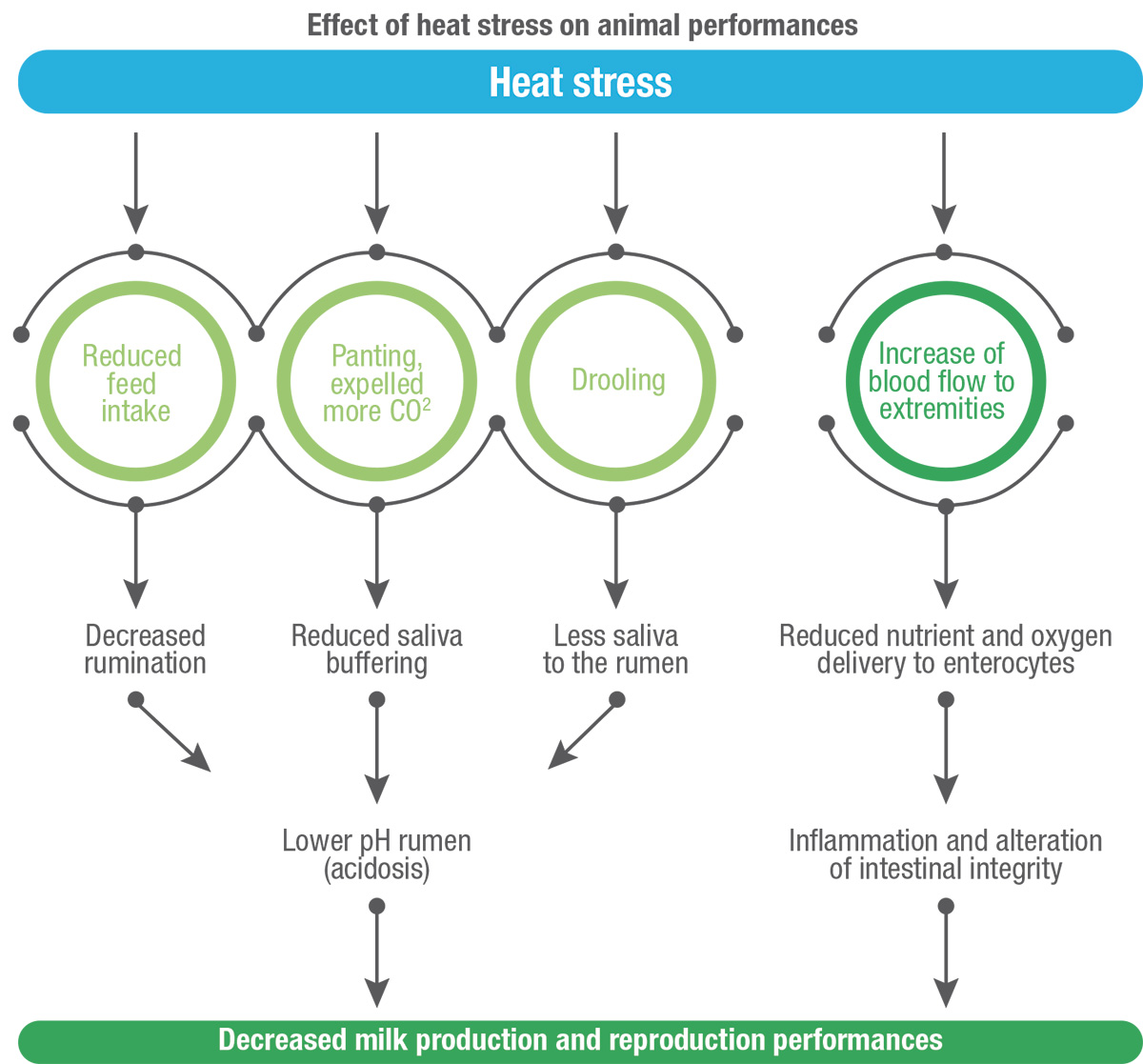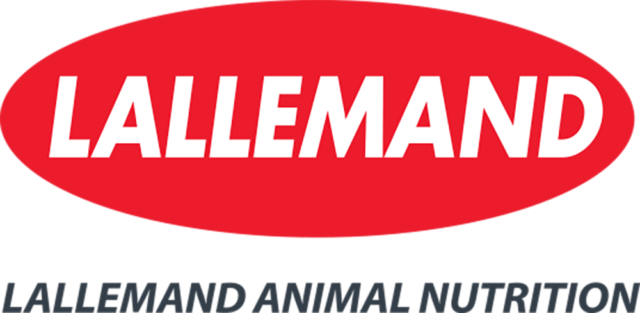Heat stress conditions can negatively affect dairy farms, from a decline in performance to significant economic losses. In Ontario and Quebec, an estimated $34.5 million per year may be lost from reduced milk solids production due to heat stress.
Dry and lactating cows are sensitive to a high temperature and humidity index (THI). Although there is variation in the research on THI thresholds where heat stress occurs, a THI greater than 68 is when heat stress can reduce feed intake, change feeding behaviour, compromise animal health, decrease milk production and impact reproductive performance.
Taking a proactive approach can help maintain cattle comfort prior to a heat stress event. Monitoring conditions and recognizing symptoms of heat stress can help guide producers on next steps to mitigate effects.
Contributing factors
In addition to temperature and humidity, certain characteristics can make dairy cattle more susceptible to heat stress. This includes age, breed, stage of production, reproductive status and weight. Weather-related stressors are the duration of high-heat periods, frequency of heat occurrence, swings in temperatures (i.e., at night) and the presence of airflow.
Know the signs
In some cases, heat stress indicators may be overlooked. Watch if cows are utilizing or avoiding stalls (especially along the outside wall and any stalls that are in the sunlight during the day, as well as stalls that are furthest from air movement), changes in lying and standing behaviour and increased bunching behaviour. Also, pay attention to rumination and respiration rate, along with when cows are eating, how many cows are eating and any variation in feed consumption over the day.
Any deviation in behaviour compared to behaviour during the cooler weather may be an early sign that their physiological and metabolic systems are threatened by heat stress. As the severity increases, cattle will begin to pant, salivate and become restless. Cattle that exhibit trembling, excessive agitation, lack of coordination or gasping for air are under extreme duress.
Heat stress symptoms
Heat stress can severely affect a dairy cow’s gastrointestinal tract. Distressed animals may develop a “leaky gut,” which is increased permeability of the intestinal cells. Barrier function is part of the cow’s defense system and is designed to prevent pathogens and toxins from entering the circulatory system. Infiltration of these molecules into the bloodstream increases a cow’s inflammatory status and could potentially lead to sepsis.
Additionally, disruptions in the cow’s acid-base balance in the blood may impact the production of bicarbonates (HCO3) and the secretion of this buffer into the saliva. For example, high ambient temperatures induce increased respiration rates (for thermoregulation) that can lead to decreased partial pressure of carbon dioxide (pCO2) in the blood and increased blood pH. The variations in blood pCO2 and pH could be high enough to produce respiratory alkalosis, which would, in turn, produce a compensatory increase in the renal excretion of bicarbonates to restore the blood pCO2/HCO3 ratio and pH. This compensation can lead to nocturnal metabolic acidosis.
Additionally, fluctuations in nutrient intake, meal size and frequency may predispose the rumen to subacute or acute ruminal acidosis. Declines in rumen pH are sometimes not obvious but can escalate to the point of fatality.
Manage risk
Dairy producers should monitor the weather forecast and alerts to proactively implement strategies that can mitigate the risk of heat stress on their herd. Shade, sprinklers and fans can improve cow comfort, as well as ample access to fresh, clean water. In fact, water requirements for a high-producing dairy cow can increase from about 100 litres per day up to at least 160 litres per day during heat events.
It is also recommended to avoid feeding during the hottest hours of the day, instead shifting to cooler periods of the morning and evening. What is in the feed is just as important as when it is fed. Rumen fermentation generates heat, and certain feeds can increase the amount of heat that needs to be dissipated. Increasing the energy density of the diet may be helpful during high-heat conditions when cows tend to reduce dry matter intake (DMI).
Other farm management practices might include implementing a fly control program so cattle don’t huddle together in defence. Regardless of the cause, as the herd bunches, cows are exposed to more body heat and less airflow, exasperating the likelihood of heat stress.

Nutritional solutions
Nutrition management is another strategy to overcome summer weather extremes. Understanding how the body prioritizes nutrients needed by the animal is the first step in leveraging nutrition as a solution to stress mitigation. Nutrient utilization naturally shifts away from production, including animal growth or reproduction, to alleviate the negative effects of stress. As nutrients are diverted to the immediate need of helping the animal cope with stress, nutrients can become limited, which ultimately impacts milk production or fetal growth.
A proactive supplementation strategy complements the cow’s diet with targeted nutrients that can be used or stored in the body. This enables the animal’s physiology to respond quickly, helping minimize the negative consequences of stress and enhancing the animal’s overall comfort. When cattle are comfortable, nutrient allocation is diverted to production efforts and cows are more likely to reach performance targets.
Functional feed additives
Scientific advances in animal nutrition have uncovered an array of ingredients that have been shown to help cattle cope with high heat. For instance, research trials have shown that certain yeasts and plant extracts can help dairy cows recover more rapidly from stress events. One approach includes a unique blend of natural ingredients, including plant extracts and Pichia guilliermondii inactivated yeast, that might improve animal thermoregulation and has been tested at university and field locations across North America for more than 15 years. This specialty compound can be used in premix, complete feed or total mixed rations (TMR) to support animal performance during extreme heat conditions. A trial at the University of Arizona has shown increases in DMI, milk production and feed efficiency in cows fed our FreshUp additive compared to control.
Another way to optimize diet formulations for summer performance is to modify ration concentrations. Greater nutrient density of protein and energy sources may help mitigate lower feed intake. Adding fat or glucose precursors to the diet can decrease the heat produced during digestion. Supplementing diets with sodium and potassium buffers is an effective practice to help reduce acidosis risk by minimizing fluctuations and declines in rumen pH. Electrolytes and vitamins can also compensate for sweat losses and improve animal function.
Food for thought
Dairy producers must keep in mind that a single nutritional additive cannot completely mitigate the negative consequences of heat stress. Feed additives vary in their impact and extent of effects on animal physiology, from rumen function to immune support and vasodilation. Also consider the environment, behaviour and other influences that may impact how the cows are consuming the product, or how the product functions in the cow. Nevertheless, feed additives worth including in cattle diets should be backed by research studies that validate their return on investment.
To avoid any unnecessary losses in performance and financial returns, these nutritional and farm management strategies should be implemented at least a few weeks prior to the first forecast day above 68 THI. Preventative actions can better prepare cows for summer and help producers support their dairy cattle to avoid economic losses due to heat stress.









